Level 5 SAQ: Legal & Regulatory Requirements in Aesthetic Practice
VerifiedAdded on 2023/06/14
|69
|19878
|67
Homework Assignment
AI Summary
This document presents a student's answers to short answer questions (SAQs) for the Level 5 Certificate in Aesthetic Practice, specifically focusing on Unit AP501, which covers legal and regulatory requirements. The answers address key areas such as an employer's legal responsibilities for health and safety, including infection control, the types of health and safety systems that should be in place, infection control protocols, and the different types of health and safety records that must be managed. The student analyzes employer responsibilities under the Health and Safety at Work Act, evaluates health and safety systems like occupational health and safety, risk assessment, training, waste management, and reporting systems, and discusses infection control protocols such as sanitizer use, sharp handling, and waste management. The responses also cover the management of health and safety records, including COSHH and risk assessments.
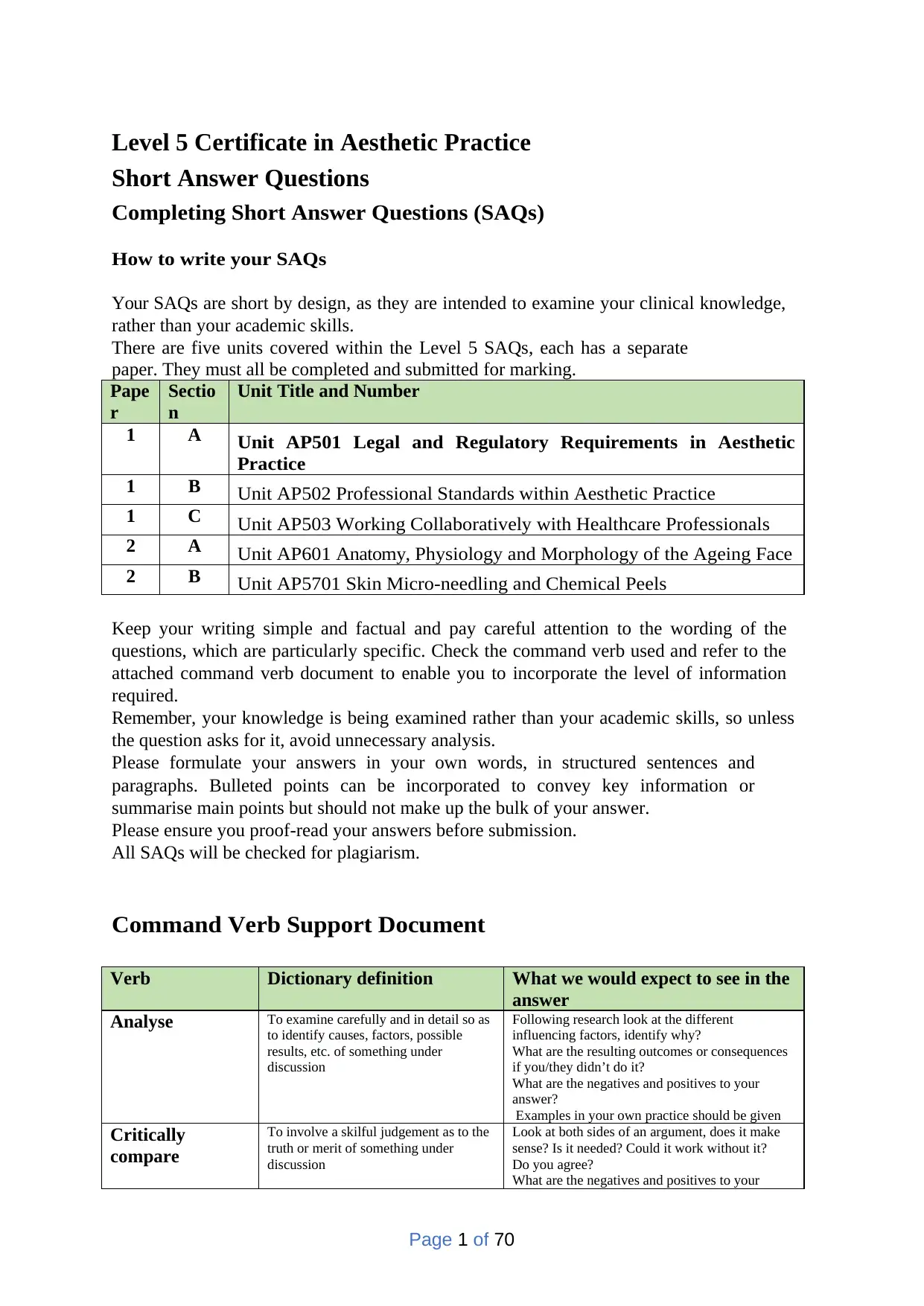
Level 5 Certificate in Aesthetic Practice
Short Answer Questions
Completing Short Answer Questions (SAQs)
How to write your SAQs
Your SAQs are short by design, as they are intended to examine your clinical knowledge,
rather than your academic skills.
There are five units covered within the Level 5 SAQs, each has a separate
paper. They must all be completed and submitted for marking.
Pape
r
Sectio
n
Unit Title and Number
1 A Unit AP501 Legal and Regulatory Requirements in Aesthetic
Practice
1 B Unit AP502 Professional Standards within Aesthetic Practice
1 C Unit AP503 Working Collaboratively with Healthcare Professionals
2 A Unit AP601 Anatomy, Physiology and Morphology of the Ageing Face
2 B Unit AP5701 Skin Micro-needling and Chemical Peels
Keep your writing simple and factual and pay careful attention to the wording of the
questions, which are particularly specific. Check the command verb used and refer to the
attached command verb document to enable you to incorporate the level of information
required.
Remember, your knowledge is being examined rather than your academic skills, so unless
the question asks for it, avoid unnecessary analysis.
Please formulate your answers in your own words, in structured sentences and
paragraphs. Bulleted points can be incorporated to convey key information or
summarise main points but should not make up the bulk of your answer.
Please ensure you proof-read your answers before submission.
All SAQs will be checked for plagiarism.
Command Verb Support Document
Verb Dictionary definition What we would expect to see in the
answer
Analyse To examine carefully and in detail so as
to identify causes, factors, possible
results, etc. of something under
discussion
Following research look at the different
influencing factors, identify why?
What are the resulting outcomes or consequences
if you/they didn’t do it?
What are the negatives and positives to your
answer?
Examples in your own practice should be given
Critically
compare
To involve a skilful judgement as to the
truth or merit of something under
discussion
Look at both sides of an argument, does it make
sense? Is it needed? Could it work without it?
Do you agree?
What are the negatives and positives to your
Page 1 of 70
Short Answer Questions
Completing Short Answer Questions (SAQs)
How to write your SAQs
Your SAQs are short by design, as they are intended to examine your clinical knowledge,
rather than your academic skills.
There are five units covered within the Level 5 SAQs, each has a separate
paper. They must all be completed and submitted for marking.
Pape
r
Sectio
n
Unit Title and Number
1 A Unit AP501 Legal and Regulatory Requirements in Aesthetic
Practice
1 B Unit AP502 Professional Standards within Aesthetic Practice
1 C Unit AP503 Working Collaboratively with Healthcare Professionals
2 A Unit AP601 Anatomy, Physiology and Morphology of the Ageing Face
2 B Unit AP5701 Skin Micro-needling and Chemical Peels
Keep your writing simple and factual and pay careful attention to the wording of the
questions, which are particularly specific. Check the command verb used and refer to the
attached command verb document to enable you to incorporate the level of information
required.
Remember, your knowledge is being examined rather than your academic skills, so unless
the question asks for it, avoid unnecessary analysis.
Please formulate your answers in your own words, in structured sentences and
paragraphs. Bulleted points can be incorporated to convey key information or
summarise main points but should not make up the bulk of your answer.
Please ensure you proof-read your answers before submission.
All SAQs will be checked for plagiarism.
Command Verb Support Document
Verb Dictionary definition What we would expect to see in the
answer
Analyse To examine carefully and in detail so as
to identify causes, factors, possible
results, etc. of something under
discussion
Following research look at the different
influencing factors, identify why?
What are the resulting outcomes or consequences
if you/they didn’t do it?
What are the negatives and positives to your
answer?
Examples in your own practice should be given
Critically
compare
To involve a skilful judgement as to the
truth or merit of something under
discussion
Look at both sides of an argument, does it make
sense? Is it needed? Could it work without it?
Do you agree?
What are the negatives and positives to your
Page 1 of 70
Paraphrase This Document
Need a fresh take? Get an instant paraphrase of this document with our AI Paraphraser

answer?
Examples in your own practice should be given
Define To make clear and state the meaning of
something under discussion
Identify and clearly make check that you have
identified the meaning of the subject in question
Describe To tell or depict in written or spoken
word; give an account of something
under discussion
What does it do?
How do you do it?
Examples should be given
Evaluate To judge or determine the significance,
worth or quality of; assess something
under discussion
What is the value of your answer? Are all the
points that you have raised necessary?
What are the negatives and positives to your
answer?
What do you feel about your answer?
What are your opinions?
Identify evidence of research or relevant models.
Do you agree with the researchers?
Explain To make clear the cause or reason of;
account for something under discussion
Give details of the subject to demonstrate your
level of understanding
Interpret To give or provide the meaning of;
something under discussion
Show understanding of the subject matter, by
researching and then showing your understanding
by giving your view of the research of the subject
matter
Outline Identify the essential features or main
aspects of something under discussion
“Pull out” the main points up for discussion in the
question
Summarise To state or express in a concise form of
something under discussion
Clearly identify the subject being referred to,
identify the key points
http://dictionary.reference.com/
Learner Name ……………………………………………………
Submission Date……………
Paper 1 – Section A
Unit AP501 Legal and Regulatory Requirements in Aesthetic
Practice
Learner Feedback
Question
No.
Assessme
nt
Criteria
Mark Assessor Feedback
1 2.1 /10
2 2.2 /10
3 2.2 /10
4 2.3 /10
5 2.4 /10
6 2.5 /10
7 4.1 /10
8 4.2 /10
Total Mark /80
To gain a pass, learners must gain a minimum of 4 marks for each question.
Minimum pass mark is 52/80 = 65%
Page 2 of 70
Examples in your own practice should be given
Define To make clear and state the meaning of
something under discussion
Identify and clearly make check that you have
identified the meaning of the subject in question
Describe To tell or depict in written or spoken
word; give an account of something
under discussion
What does it do?
How do you do it?
Examples should be given
Evaluate To judge or determine the significance,
worth or quality of; assess something
under discussion
What is the value of your answer? Are all the
points that you have raised necessary?
What are the negatives and positives to your
answer?
What do you feel about your answer?
What are your opinions?
Identify evidence of research or relevant models.
Do you agree with the researchers?
Explain To make clear the cause or reason of;
account for something under discussion
Give details of the subject to demonstrate your
level of understanding
Interpret To give or provide the meaning of;
something under discussion
Show understanding of the subject matter, by
researching and then showing your understanding
by giving your view of the research of the subject
matter
Outline Identify the essential features or main
aspects of something under discussion
“Pull out” the main points up for discussion in the
question
Summarise To state or express in a concise form of
something under discussion
Clearly identify the subject being referred to,
identify the key points
http://dictionary.reference.com/
Learner Name ……………………………………………………
Submission Date……………
Paper 1 – Section A
Unit AP501 Legal and Regulatory Requirements in Aesthetic
Practice
Learner Feedback
Question
No.
Assessme
nt
Criteria
Mark Assessor Feedback
1 2.1 /10
2 2.2 /10
3 2.2 /10
4 2.3 /10
5 2.4 /10
6 2.5 /10
7 4.1 /10
8 4.2 /10
Total Mark /80
To gain a pass, learners must gain a minimum of 4 marks for each question.
Minimum pass mark is 52/80 = 65%
Page 2 of 70
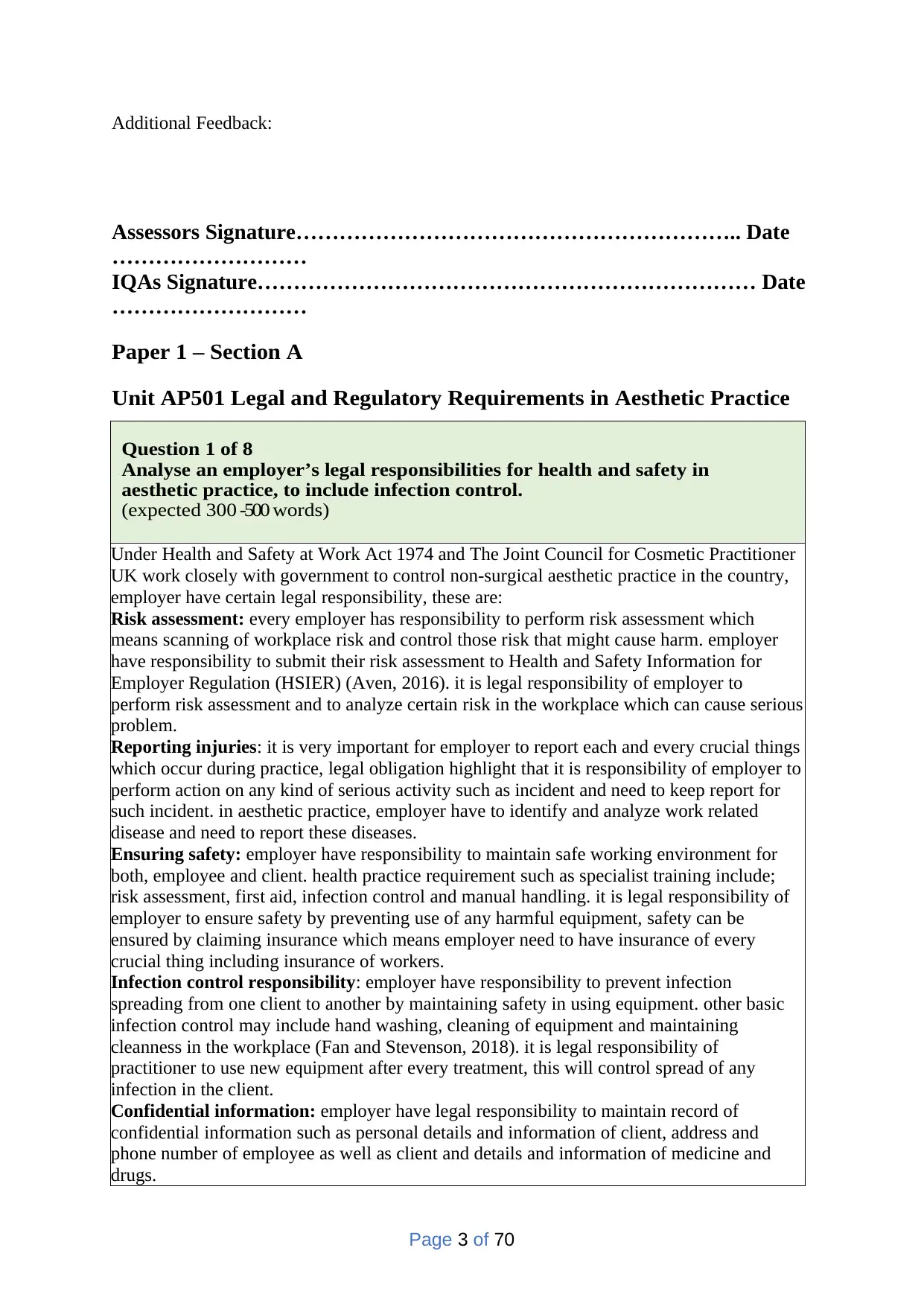
Additional Feedback:
Assessors Signature…………………………………………………….. Date
………………………
IQAs Signature…………………………………………………………… Date
………………………
Paper 1 – Section A
Unit AP501 Legal and Regulatory Requirements in Aesthetic Practice
Question 1 of 8
Analyse an employer’s legal responsibilities for health and safety in
aesthetic practice, to include infection control.
(expected 300 -500 words)
Under Health and Safety at Work Act 1974 and The Joint Council for Cosmetic Practitioner
UK work closely with government to control non-surgical aesthetic practice in the country,
employer have certain legal responsibility, these are:
Risk assessment: every employer has responsibility to perform risk assessment which
means scanning of workplace risk and control those risk that might cause harm. employer
have responsibility to submit their risk assessment to Health and Safety Information for
Employer Regulation (HSIER) (Aven, 2016). it is legal responsibility of employer to
perform risk assessment and to analyze certain risk in the workplace which can cause serious
problem.
Reporting injuries: it is very important for employer to report each and every crucial things
which occur during practice, legal obligation highlight that it is responsibility of employer to
perform action on any kind of serious activity such as incident and need to keep report for
such incident. in aesthetic practice, employer have to identify and analyze work related
disease and need to report these diseases.
Ensuring safety: employer have responsibility to maintain safe working environment for
both, employee and client. health practice requirement such as specialist training include;
risk assessment, first aid, infection control and manual handling. it is legal responsibility of
employer to ensure safety by preventing use of any harmful equipment, safety can be
ensured by claiming insurance which means employer need to have insurance of every
crucial thing including insurance of workers.
Infection control responsibility: employer have responsibility to prevent infection
spreading from one client to another by maintaining safety in using equipment. other basic
infection control may include hand washing, cleaning of equipment and maintaining
cleanness in the workplace (Fan and Stevenson, 2018). it is legal responsibility of
practitioner to use new equipment after every treatment, this will control spread of any
infection in the client.
Confidential information: employer have legal responsibility to maintain record of
confidential information such as personal details and information of client, address and
phone number of employee as well as client and details and information of medicine and
drugs.
Page 3 of 70
Assessors Signature…………………………………………………….. Date
………………………
IQAs Signature…………………………………………………………… Date
………………………
Paper 1 – Section A
Unit AP501 Legal and Regulatory Requirements in Aesthetic Practice
Question 1 of 8
Analyse an employer’s legal responsibilities for health and safety in
aesthetic practice, to include infection control.
(expected 300 -500 words)
Under Health and Safety at Work Act 1974 and The Joint Council for Cosmetic Practitioner
UK work closely with government to control non-surgical aesthetic practice in the country,
employer have certain legal responsibility, these are:
Risk assessment: every employer has responsibility to perform risk assessment which
means scanning of workplace risk and control those risk that might cause harm. employer
have responsibility to submit their risk assessment to Health and Safety Information for
Employer Regulation (HSIER) (Aven, 2016). it is legal responsibility of employer to
perform risk assessment and to analyze certain risk in the workplace which can cause serious
problem.
Reporting injuries: it is very important for employer to report each and every crucial things
which occur during practice, legal obligation highlight that it is responsibility of employer to
perform action on any kind of serious activity such as incident and need to keep report for
such incident. in aesthetic practice, employer have to identify and analyze work related
disease and need to report these diseases.
Ensuring safety: employer have responsibility to maintain safe working environment for
both, employee and client. health practice requirement such as specialist training include;
risk assessment, first aid, infection control and manual handling. it is legal responsibility of
employer to ensure safety by preventing use of any harmful equipment, safety can be
ensured by claiming insurance which means employer need to have insurance of every
crucial thing including insurance of workers.
Infection control responsibility: employer have responsibility to prevent infection
spreading from one client to another by maintaining safety in using equipment. other basic
infection control may include hand washing, cleaning of equipment and maintaining
cleanness in the workplace (Fan and Stevenson, 2018). it is legal responsibility of
practitioner to use new equipment after every treatment, this will control spread of any
infection in the client.
Confidential information: employer have legal responsibility to maintain record of
confidential information such as personal details and information of client, address and
phone number of employee as well as client and details and information of medicine and
drugs.
Page 3 of 70
⊘ This is a preview!⊘
Do you want full access?
Subscribe today to unlock all pages.

Trusted by 1+ million students worldwide

Word Count: Assessment
Criteria 2.1
To be completed by the assessor Possible marks:10 Total Marks:
Paper 1 – Section A
Unit AP501 Legal and Regulatory Requirements in Aesthetic Practice
Question 2 of 8
Evaluate the types of health and safety systems that should be in place for
aesthetic practice.
(expected 300-500 words)
Health and safety is backbone of every clinic or organization, this ensure safety of employer,
employee and workplace. every aesthetic clinic has their own system for managing health
and safety, there are different types of systems, these are:
Occupational health and safety system: occupational health and safety system allow
organization to maintain safety of worker in the workplace, an aesthetic practice clinic
should follow this system to manage any uncertainty that may arrive (Adei, Braimah and
Mensah, 2019). ISO 45001 ensure organization should maintain safety of lives while
performing work, in aesthetic practice, occupational health and safety system play vital role.
Page 4 of 70
Criteria 2.1
To be completed by the assessor Possible marks:10 Total Marks:
Paper 1 – Section A
Unit AP501 Legal and Regulatory Requirements in Aesthetic Practice
Question 2 of 8
Evaluate the types of health and safety systems that should be in place for
aesthetic practice.
(expected 300-500 words)
Health and safety is backbone of every clinic or organization, this ensure safety of employer,
employee and workplace. every aesthetic clinic has their own system for managing health
and safety, there are different types of systems, these are:
Occupational health and safety system: occupational health and safety system allow
organization to maintain safety of worker in the workplace, an aesthetic practice clinic
should follow this system to manage any uncertainty that may arrive (Adei, Braimah and
Mensah, 2019). ISO 45001 ensure organization should maintain safety of lives while
performing work, in aesthetic practice, occupational health and safety system play vital role.
Page 4 of 70
Paraphrase This Document
Need a fresh take? Get an instant paraphrase of this document with our AI Paraphraser

Occupational risk assessment system: occupational risk assessment is one the most
effective health and safety system that ensure risk is minimize in the workplace, this system
allow employer to perform risk assessment to analyze those area of workplace where
uncertainty may arrive. in aesthetic practice, worker have to perform risk assessment to
analyze internal risk that may arise during treatment.
Training and induction system: training and induction play vital role in health and safety,
aesthetic practice, organization have to provides effective training to staff member which can
ensure high quality of non-surgical treatment. training unlock certain doors for staff member
allowing them to become professional in aesthetic practice. training system is must require
in aesthetic practice because treatment process cannot be done with lack of knowledge.
Waste management system: waste management is another important part of health and
safety system; this ensure clinic remain safe from any kind of infectious spreading disease.
in aesthetic practice, worker need to manage waste occur after treatment for example; if
facial treatment is done then they have to manage those waste which any occur during
treatment.
Reporting and recording system: reporting and recording play vital role in health and
safety system as this will ensure management of medical records. in aesthetic practice, clinic
have to ensure every medical record is managed properly.
Word Count: Assessment
Criteria 2.2
Page 5 of 70
effective health and safety system that ensure risk is minimize in the workplace, this system
allow employer to perform risk assessment to analyze those area of workplace where
uncertainty may arrive. in aesthetic practice, worker have to perform risk assessment to
analyze internal risk that may arise during treatment.
Training and induction system: training and induction play vital role in health and safety,
aesthetic practice, organization have to provides effective training to staff member which can
ensure high quality of non-surgical treatment. training unlock certain doors for staff member
allowing them to become professional in aesthetic practice. training system is must require
in aesthetic practice because treatment process cannot be done with lack of knowledge.
Waste management system: waste management is another important part of health and
safety system; this ensure clinic remain safe from any kind of infectious spreading disease.
in aesthetic practice, worker need to manage waste occur after treatment for example; if
facial treatment is done then they have to manage those waste which any occur during
treatment.
Reporting and recording system: reporting and recording play vital role in health and
safety system as this will ensure management of medical records. in aesthetic practice, clinic
have to ensure every medical record is managed properly.
Word Count: Assessment
Criteria 2.2
Page 5 of 70
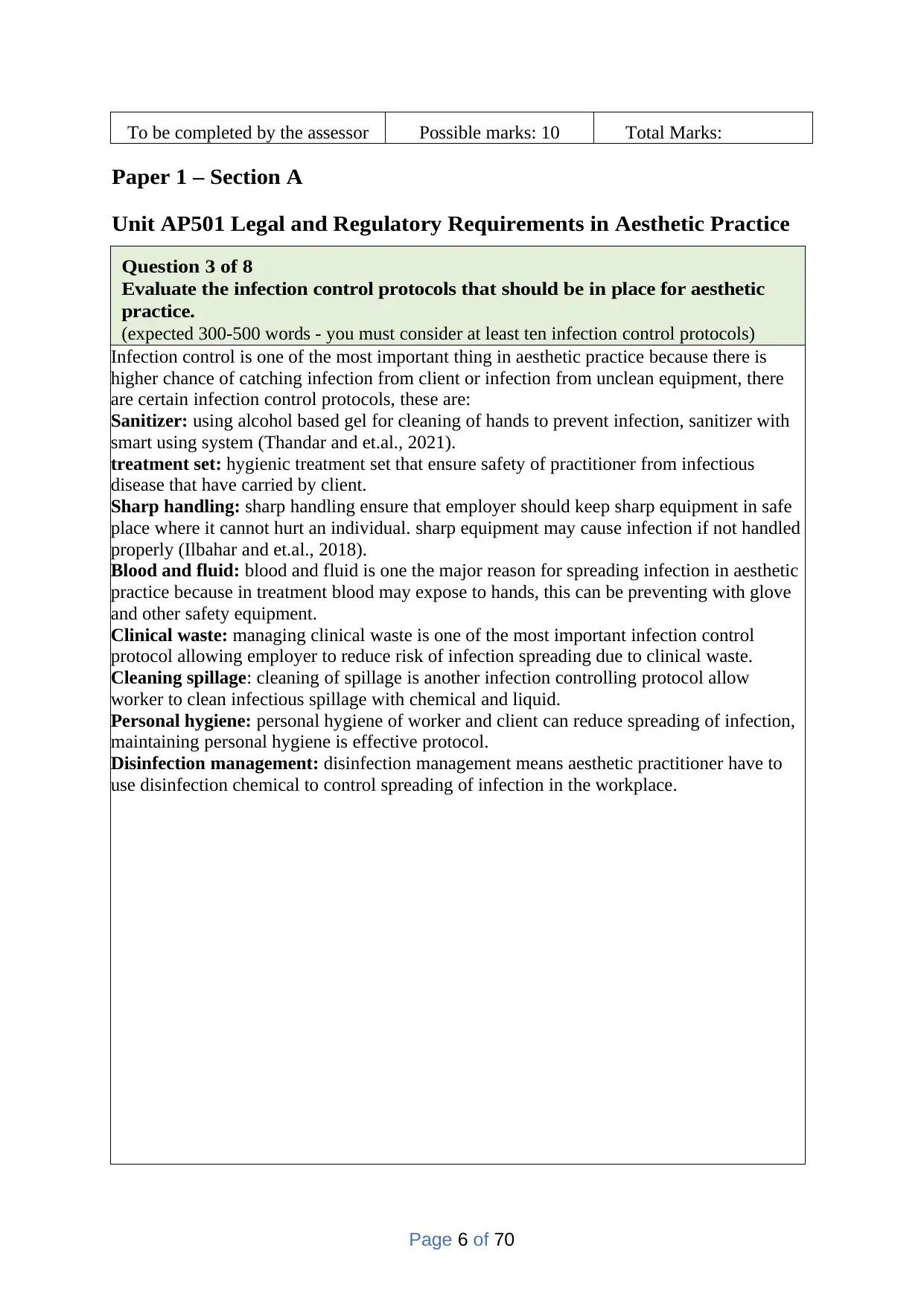
To be completed by the assessor Possible marks: 10 Total Marks:
Paper 1 – Section A
Unit AP501 Legal and Regulatory Requirements in Aesthetic Practice
Question 3 of 8
Evaluate the infection control protocols that should be in place for aesthetic
practice.
(expected 300-500 words - you must consider at least ten infection control protocols)
Infection control is one of the most important thing in aesthetic practice because there is
higher chance of catching infection from client or infection from unclean equipment, there
are certain infection control protocols, these are:
Sanitizer: using alcohol based gel for cleaning of hands to prevent infection, sanitizer with
smart using system (Thandar and et.al., 2021).
treatment set: hygienic treatment set that ensure safety of practitioner from infectious
disease that have carried by client.
Sharp handling: sharp handling ensure that employer should keep sharp equipment in safe
place where it cannot hurt an individual. sharp equipment may cause infection if not handled
properly (Ilbahar and et.al., 2018).
Blood and fluid: blood and fluid is one the major reason for spreading infection in aesthetic
practice because in treatment blood may expose to hands, this can be preventing with glove
and other safety equipment.
Clinical waste: managing clinical waste is one of the most important infection control
protocol allowing employer to reduce risk of infection spreading due to clinical waste.
Cleaning spillage: cleaning of spillage is another infection controlling protocol allow
worker to clean infectious spillage with chemical and liquid.
Personal hygiene: personal hygiene of worker and client can reduce spreading of infection,
maintaining personal hygiene is effective protocol.
Disinfection management: disinfection management means aesthetic practitioner have to
use disinfection chemical to control spreading of infection in the workplace.
Page 6 of 70
Paper 1 – Section A
Unit AP501 Legal and Regulatory Requirements in Aesthetic Practice
Question 3 of 8
Evaluate the infection control protocols that should be in place for aesthetic
practice.
(expected 300-500 words - you must consider at least ten infection control protocols)
Infection control is one of the most important thing in aesthetic practice because there is
higher chance of catching infection from client or infection from unclean equipment, there
are certain infection control protocols, these are:
Sanitizer: using alcohol based gel for cleaning of hands to prevent infection, sanitizer with
smart using system (Thandar and et.al., 2021).
treatment set: hygienic treatment set that ensure safety of practitioner from infectious
disease that have carried by client.
Sharp handling: sharp handling ensure that employer should keep sharp equipment in safe
place where it cannot hurt an individual. sharp equipment may cause infection if not handled
properly (Ilbahar and et.al., 2018).
Blood and fluid: blood and fluid is one the major reason for spreading infection in aesthetic
practice because in treatment blood may expose to hands, this can be preventing with glove
and other safety equipment.
Clinical waste: managing clinical waste is one of the most important infection control
protocol allowing employer to reduce risk of infection spreading due to clinical waste.
Cleaning spillage: cleaning of spillage is another infection controlling protocol allow
worker to clean infectious spillage with chemical and liquid.
Personal hygiene: personal hygiene of worker and client can reduce spreading of infection,
maintaining personal hygiene is effective protocol.
Disinfection management: disinfection management means aesthetic practitioner have to
use disinfection chemical to control spreading of infection in the workplace.
Page 6 of 70
⊘ This is a preview!⊘
Do you want full access?
Subscribe today to unlock all pages.

Trusted by 1+ million students worldwide
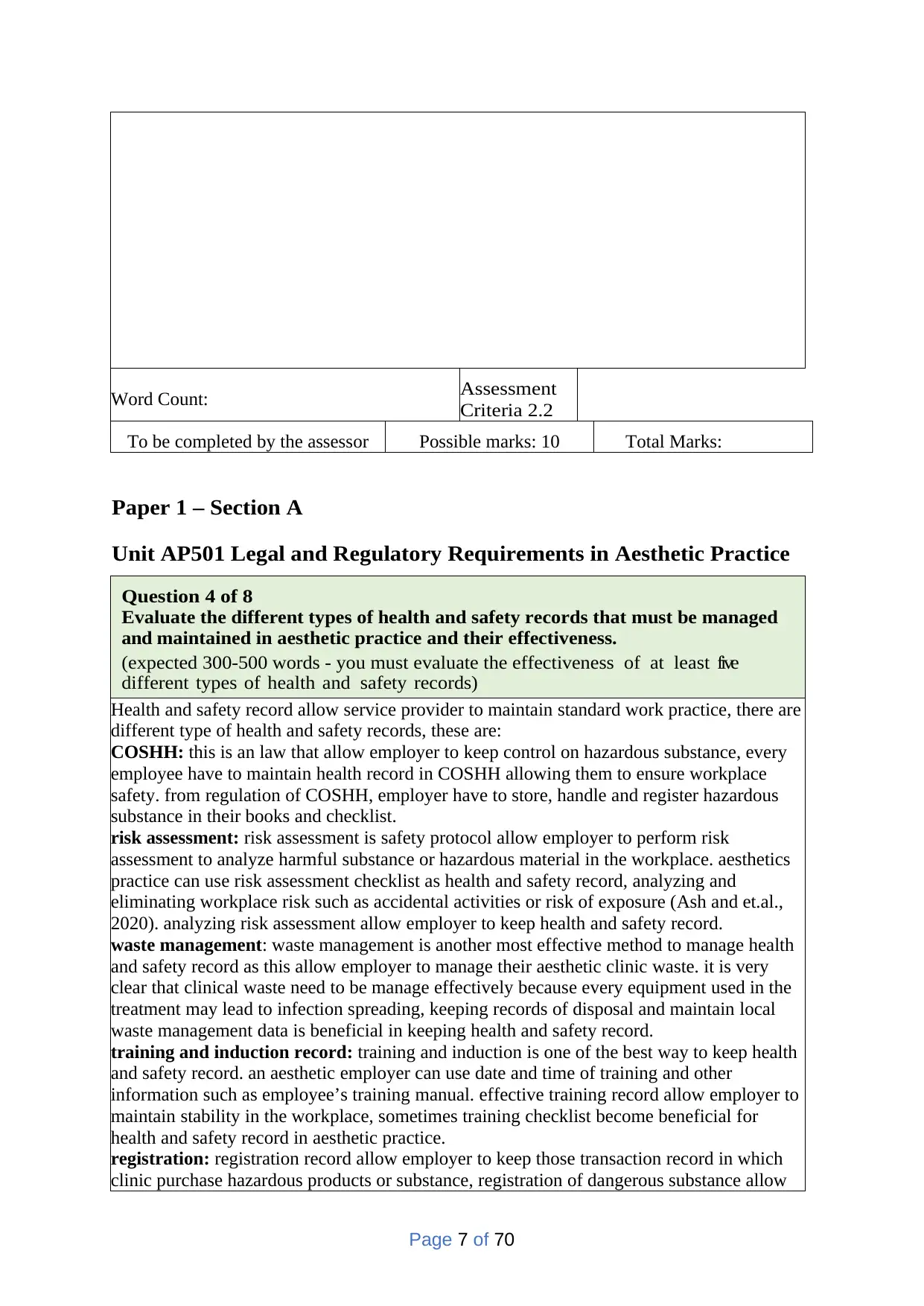
Word Count: Assessment
Criteria 2.2
To be completed by the assessor Possible marks: 10 Total Marks:
Paper 1 – Section A
Unit AP501 Legal and Regulatory Requirements in Aesthetic Practice
Question 4 of 8
Evaluate the different types of health and safety records that must be managed
and maintained in aesthetic practice and their effectiveness.
(expected 300-500 words - you must evaluate the effectiveness of at least five
different types of health and safety records)
Health and safety record allow service provider to maintain standard work practice, there are
different type of health and safety records, these are:
COSHH: this is an law that allow employer to keep control on hazardous substance, every
employee have to maintain health record in COSHH allowing them to ensure workplace
safety. from regulation of COSHH, employer have to store, handle and register hazardous
substance in their books and checklist.
risk assessment: risk assessment is safety protocol allow employer to perform risk
assessment to analyze harmful substance or hazardous material in the workplace. aesthetics
practice can use risk assessment checklist as health and safety record, analyzing and
eliminating workplace risk such as accidental activities or risk of exposure (Ash and et.al.,
2020). analyzing risk assessment allow employer to keep health and safety record.
waste management: waste management is another most effective method to manage health
and safety record as this allow employer to manage their aesthetic clinic waste. it is very
clear that clinical waste need to be manage effectively because every equipment used in the
treatment may lead to infection spreading, keeping records of disposal and maintain local
waste management data is beneficial in keeping health and safety record.
training and induction record: training and induction is one of the best way to keep health
and safety record. an aesthetic employer can use date and time of training and other
information such as employee’s training manual. effective training record allow employer to
maintain stability in the workplace, sometimes training checklist become beneficial for
health and safety record in aesthetic practice.
registration: registration record allow employer to keep those transaction record in which
clinic purchase hazardous products or substance, registration of dangerous substance allow
Page 7 of 70
Criteria 2.2
To be completed by the assessor Possible marks: 10 Total Marks:
Paper 1 – Section A
Unit AP501 Legal and Regulatory Requirements in Aesthetic Practice
Question 4 of 8
Evaluate the different types of health and safety records that must be managed
and maintained in aesthetic practice and their effectiveness.
(expected 300-500 words - you must evaluate the effectiveness of at least five
different types of health and safety records)
Health and safety record allow service provider to maintain standard work practice, there are
different type of health and safety records, these are:
COSHH: this is an law that allow employer to keep control on hazardous substance, every
employee have to maintain health record in COSHH allowing them to ensure workplace
safety. from regulation of COSHH, employer have to store, handle and register hazardous
substance in their books and checklist.
risk assessment: risk assessment is safety protocol allow employer to perform risk
assessment to analyze harmful substance or hazardous material in the workplace. aesthetics
practice can use risk assessment checklist as health and safety record, analyzing and
eliminating workplace risk such as accidental activities or risk of exposure (Ash and et.al.,
2020). analyzing risk assessment allow employer to keep health and safety record.
waste management: waste management is another most effective method to manage health
and safety record as this allow employer to manage their aesthetic clinic waste. it is very
clear that clinical waste need to be manage effectively because every equipment used in the
treatment may lead to infection spreading, keeping records of disposal and maintain local
waste management data is beneficial in keeping health and safety record.
training and induction record: training and induction is one of the best way to keep health
and safety record. an aesthetic employer can use date and time of training and other
information such as employee’s training manual. effective training record allow employer to
maintain stability in the workplace, sometimes training checklist become beneficial for
health and safety record in aesthetic practice.
registration: registration record allow employer to keep those transaction record in which
clinic purchase hazardous products or substance, registration of dangerous substance allow
Page 7 of 70
Paraphrase This Document
Need a fresh take? Get an instant paraphrase of this document with our AI Paraphraser
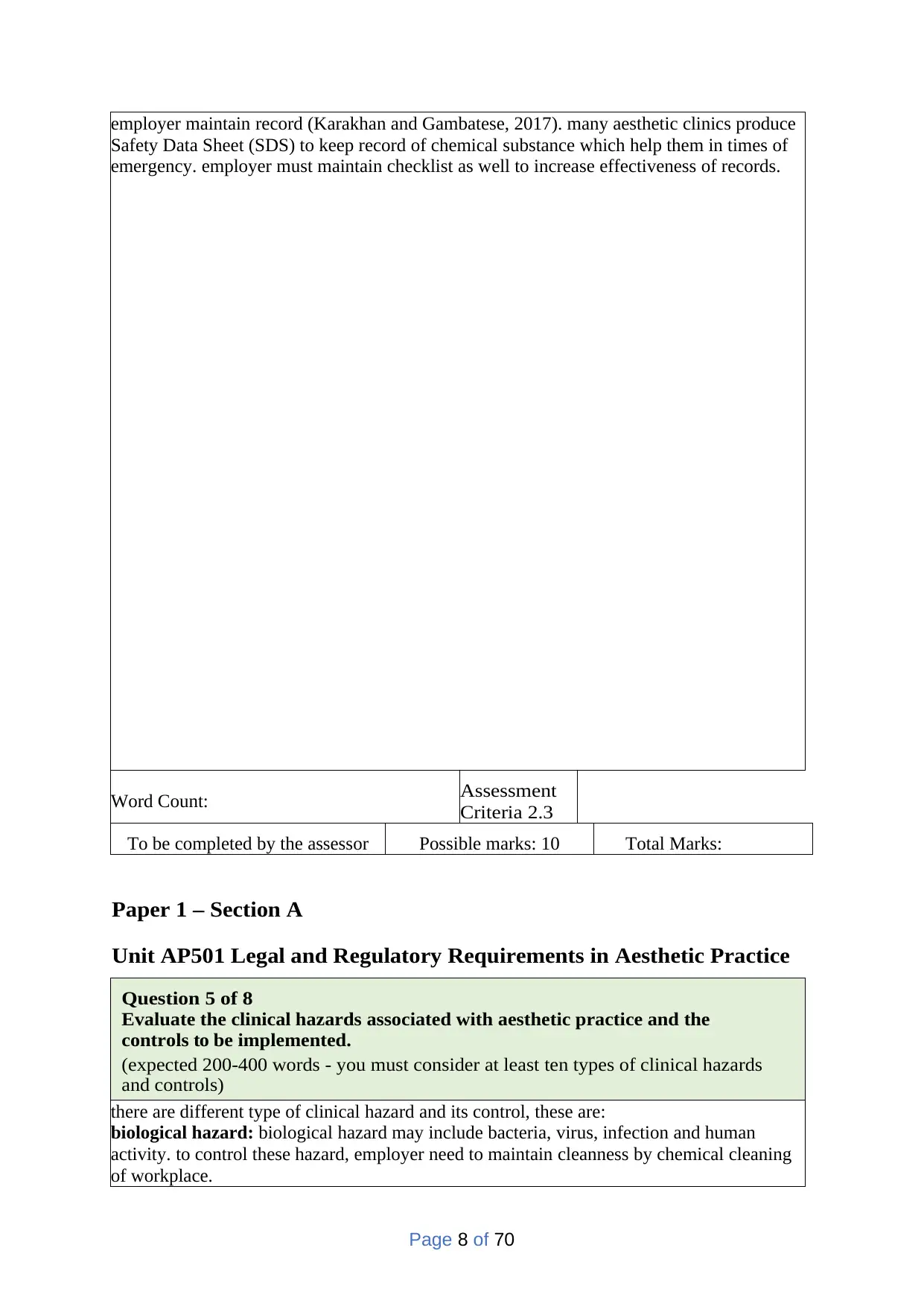
employer maintain record (Karakhan and Gambatese, 2017). many aesthetic clinics produce
Safety Data Sheet (SDS) to keep record of chemical substance which help them in times of
emergency. employer must maintain checklist as well to increase effectiveness of records.
Word Count: Assessment
Criteria 2.3
To be completed by the assessor Possible marks: 10 Total Marks:
Paper 1 – Section A
Unit AP501 Legal and Regulatory Requirements in Aesthetic Practice
Question 5 of 8
Evaluate the clinical hazards associated with aesthetic practice and the
controls to be implemented.
(expected 200-400 words - you must consider at least ten types of clinical hazards
and controls)
there are different type of clinical hazard and its control, these are:
biological hazard: biological hazard may include bacteria, virus, infection and human
activity. to control these hazard, employer need to maintain cleanness by chemical cleaning
of workplace.
Page 8 of 70
Safety Data Sheet (SDS) to keep record of chemical substance which help them in times of
emergency. employer must maintain checklist as well to increase effectiveness of records.
Word Count: Assessment
Criteria 2.3
To be completed by the assessor Possible marks: 10 Total Marks:
Paper 1 – Section A
Unit AP501 Legal and Regulatory Requirements in Aesthetic Practice
Question 5 of 8
Evaluate the clinical hazards associated with aesthetic practice and the
controls to be implemented.
(expected 200-400 words - you must consider at least ten types of clinical hazards
and controls)
there are different type of clinical hazard and its control, these are:
biological hazard: biological hazard may include bacteria, virus, infection and human
activity. to control these hazard, employer need to maintain cleanness by chemical cleaning
of workplace.
Page 8 of 70
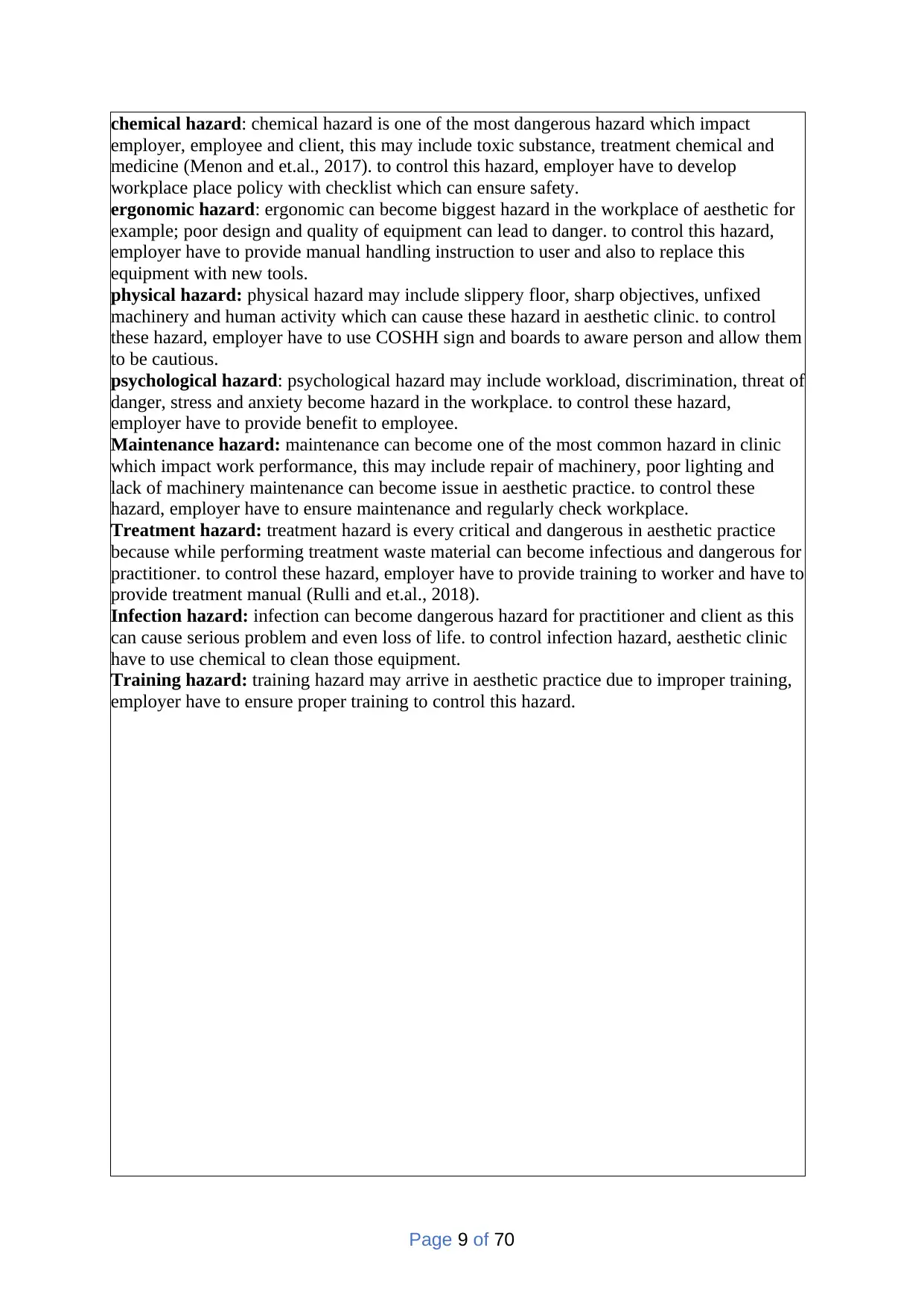
chemical hazard: chemical hazard is one of the most dangerous hazard which impact
employer, employee and client, this may include toxic substance, treatment chemical and
medicine (Menon and et.al., 2017). to control this hazard, employer have to develop
workplace place policy with checklist which can ensure safety.
ergonomic hazard: ergonomic can become biggest hazard in the workplace of aesthetic for
example; poor design and quality of equipment can lead to danger. to control this hazard,
employer have to provide manual handling instruction to user and also to replace this
equipment with new tools.
physical hazard: physical hazard may include slippery floor, sharp objectives, unfixed
machinery and human activity which can cause these hazard in aesthetic clinic. to control
these hazard, employer have to use COSHH sign and boards to aware person and allow them
to be cautious.
psychological hazard: psychological hazard may include workload, discrimination, threat of
danger, stress and anxiety become hazard in the workplace. to control these hazard,
employer have to provide benefit to employee.
Maintenance hazard: maintenance can become one of the most common hazard in clinic
which impact work performance, this may include repair of machinery, poor lighting and
lack of machinery maintenance can become issue in aesthetic practice. to control these
hazard, employer have to ensure maintenance and regularly check workplace.
Treatment hazard: treatment hazard is every critical and dangerous in aesthetic practice
because while performing treatment waste material can become infectious and dangerous for
practitioner. to control these hazard, employer have to provide training to worker and have to
provide treatment manual (Rulli and et.al., 2018).
Infection hazard: infection can become dangerous hazard for practitioner and client as this
can cause serious problem and even loss of life. to control infection hazard, aesthetic clinic
have to use chemical to clean those equipment.
Training hazard: training hazard may arrive in aesthetic practice due to improper training,
employer have to ensure proper training to control this hazard.
Page 9 of 70
employer, employee and client, this may include toxic substance, treatment chemical and
medicine (Menon and et.al., 2017). to control this hazard, employer have to develop
workplace place policy with checklist which can ensure safety.
ergonomic hazard: ergonomic can become biggest hazard in the workplace of aesthetic for
example; poor design and quality of equipment can lead to danger. to control this hazard,
employer have to provide manual handling instruction to user and also to replace this
equipment with new tools.
physical hazard: physical hazard may include slippery floor, sharp objectives, unfixed
machinery and human activity which can cause these hazard in aesthetic clinic. to control
these hazard, employer have to use COSHH sign and boards to aware person and allow them
to be cautious.
psychological hazard: psychological hazard may include workload, discrimination, threat of
danger, stress and anxiety become hazard in the workplace. to control these hazard,
employer have to provide benefit to employee.
Maintenance hazard: maintenance can become one of the most common hazard in clinic
which impact work performance, this may include repair of machinery, poor lighting and
lack of machinery maintenance can become issue in aesthetic practice. to control these
hazard, employer have to ensure maintenance and regularly check workplace.
Treatment hazard: treatment hazard is every critical and dangerous in aesthetic practice
because while performing treatment waste material can become infectious and dangerous for
practitioner. to control these hazard, employer have to provide training to worker and have to
provide treatment manual (Rulli and et.al., 2018).
Infection hazard: infection can become dangerous hazard for practitioner and client as this
can cause serious problem and even loss of life. to control infection hazard, aesthetic clinic
have to use chemical to clean those equipment.
Training hazard: training hazard may arrive in aesthetic practice due to improper training,
employer have to ensure proper training to control this hazard.
Page 9 of 70
⊘ This is a preview!⊘
Do you want full access?
Subscribe today to unlock all pages.

Trusted by 1+ million students worldwide
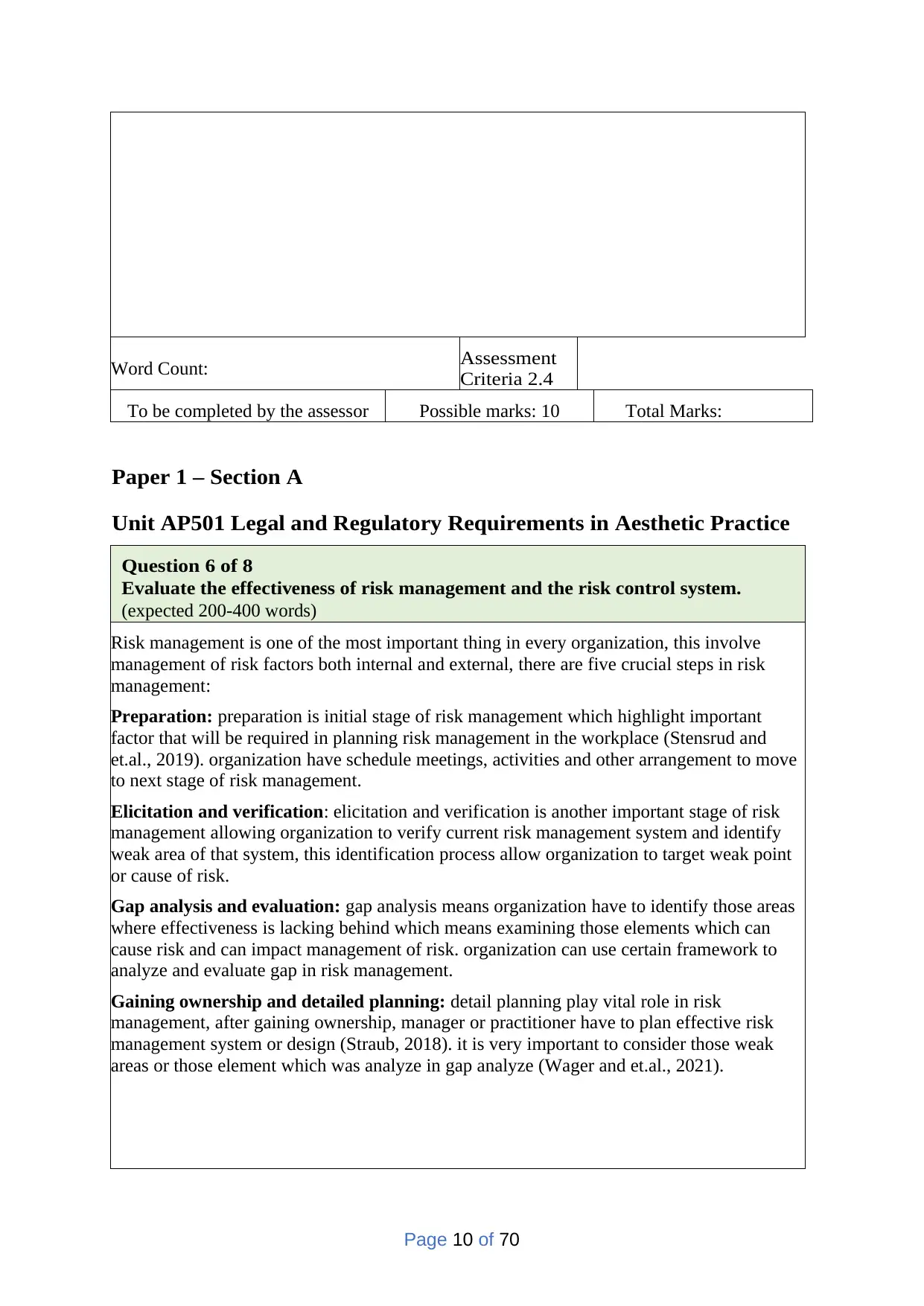
Word Count: Assessment
Criteria 2.4
To be completed by the assessor Possible marks: 10 Total Marks:
Paper 1 – Section A
Unit AP501 Legal and Regulatory Requirements in Aesthetic Practice
Question 6 of 8
Evaluate the effectiveness of risk management and the risk control system.
(expected 200-400 words)
Risk management is one of the most important thing in every organization, this involve
management of risk factors both internal and external, there are five crucial steps in risk
management:
Preparation: preparation is initial stage of risk management which highlight important
factor that will be required in planning risk management in the workplace (Stensrud and
et.al., 2019). organization have schedule meetings, activities and other arrangement to move
to next stage of risk management.
Elicitation and verification: elicitation and verification is another important stage of risk
management allowing organization to verify current risk management system and identify
weak area of that system, this identification process allow organization to target weak point
or cause of risk.
Gap analysis and evaluation: gap analysis means organization have to identify those areas
where effectiveness is lacking behind which means examining those elements which can
cause risk and can impact management of risk. organization can use certain framework to
analyze and evaluate gap in risk management.
Gaining ownership and detailed planning: detail planning play vital role in risk
management, after gaining ownership, manager or practitioner have to plan effective risk
management system or design (Straub, 2018). it is very important to consider those weak
areas or those element which was analyze in gap analyze (Wager and et.al., 2021).
Page 10 of 70
Criteria 2.4
To be completed by the assessor Possible marks: 10 Total Marks:
Paper 1 – Section A
Unit AP501 Legal and Regulatory Requirements in Aesthetic Practice
Question 6 of 8
Evaluate the effectiveness of risk management and the risk control system.
(expected 200-400 words)
Risk management is one of the most important thing in every organization, this involve
management of risk factors both internal and external, there are five crucial steps in risk
management:
Preparation: preparation is initial stage of risk management which highlight important
factor that will be required in planning risk management in the workplace (Stensrud and
et.al., 2019). organization have schedule meetings, activities and other arrangement to move
to next stage of risk management.
Elicitation and verification: elicitation and verification is another important stage of risk
management allowing organization to verify current risk management system and identify
weak area of that system, this identification process allow organization to target weak point
or cause of risk.
Gap analysis and evaluation: gap analysis means organization have to identify those areas
where effectiveness is lacking behind which means examining those elements which can
cause risk and can impact management of risk. organization can use certain framework to
analyze and evaluate gap in risk management.
Gaining ownership and detailed planning: detail planning play vital role in risk
management, after gaining ownership, manager or practitioner have to plan effective risk
management system or design (Straub, 2018). it is very important to consider those weak
areas or those element which was analyze in gap analyze (Wager and et.al., 2021).
Page 10 of 70
Paraphrase This Document
Need a fresh take? Get an instant paraphrase of this document with our AI Paraphraser
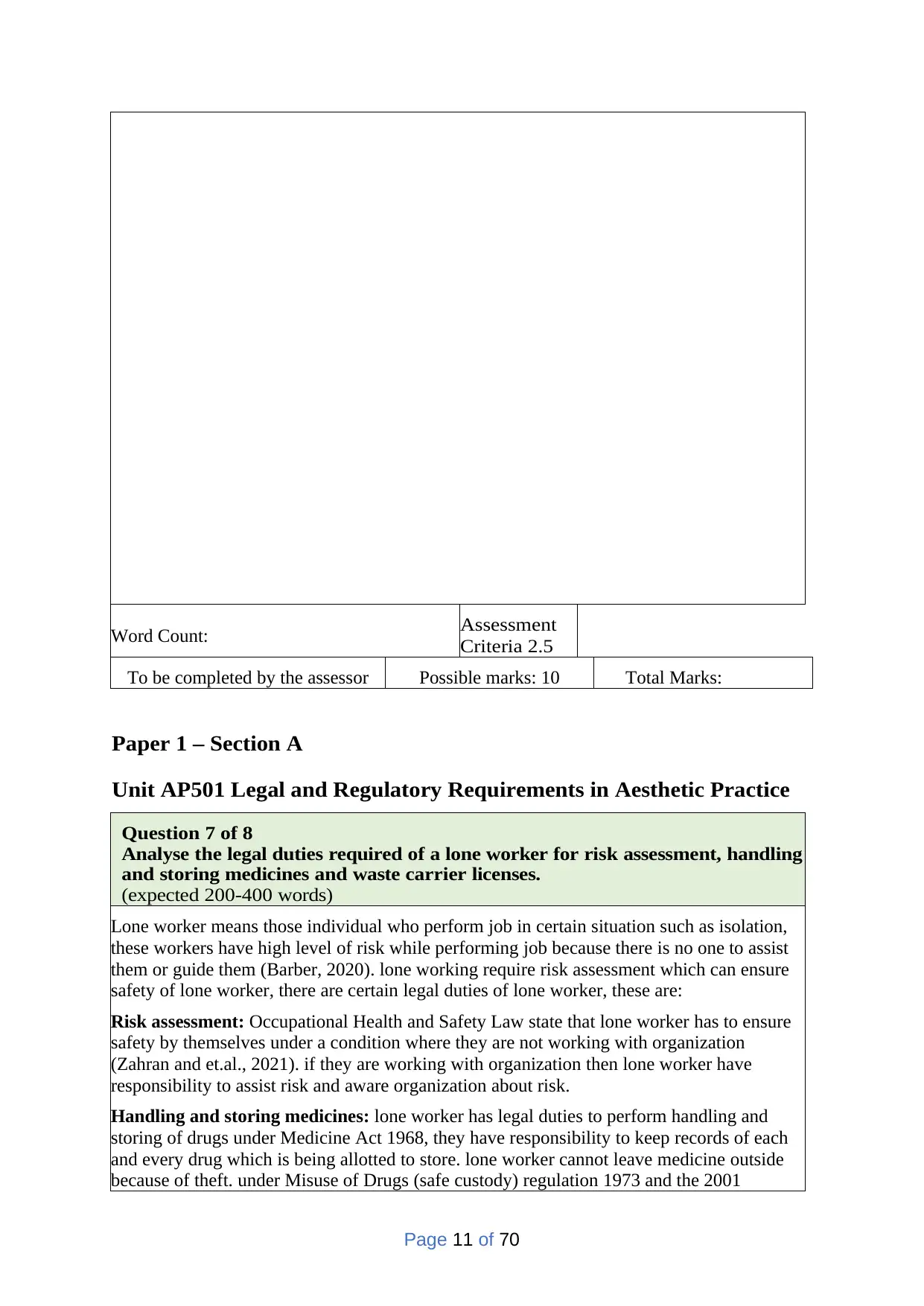
Word Count: Assessment
Criteria 2.5
To be completed by the assessor Possible marks: 10 Total Marks:
Paper 1 – Section A
Unit AP501 Legal and Regulatory Requirements in Aesthetic Practice
Question 7 of 8
Analyse the legal duties required of a lone worker for risk assessment, handling
and storing medicines and waste carrier licenses.
(expected 200-400 words)
Lone worker means those individual who perform job in certain situation such as isolation,
these workers have high level of risk while performing job because there is no one to assist
them or guide them (Barber, 2020). lone working require risk assessment which can ensure
safety of lone worker, there are certain legal duties of lone worker, these are:
Risk assessment: Occupational Health and Safety Law state that lone worker has to ensure
safety by themselves under a condition where they are not working with organization
(Zahran and et.al., 2021). if they are working with organization then lone worker have
responsibility to assist risk and aware organization about risk.
Handling and storing medicines: lone worker has legal duties to perform handling and
storing of drugs under Medicine Act 1968, they have responsibility to keep records of each
and every drug which is being allotted to store. lone worker cannot leave medicine outside
because of theft. under Misuse of Drugs (safe custody) regulation 1973 and the 2001
Page 11 of 70
Criteria 2.5
To be completed by the assessor Possible marks: 10 Total Marks:
Paper 1 – Section A
Unit AP501 Legal and Regulatory Requirements in Aesthetic Practice
Question 7 of 8
Analyse the legal duties required of a lone worker for risk assessment, handling
and storing medicines and waste carrier licenses.
(expected 200-400 words)
Lone worker means those individual who perform job in certain situation such as isolation,
these workers have high level of risk while performing job because there is no one to assist
them or guide them (Barber, 2020). lone working require risk assessment which can ensure
safety of lone worker, there are certain legal duties of lone worker, these are:
Risk assessment: Occupational Health and Safety Law state that lone worker has to ensure
safety by themselves under a condition where they are not working with organization
(Zahran and et.al., 2021). if they are working with organization then lone worker have
responsibility to assist risk and aware organization about risk.
Handling and storing medicines: lone worker has legal duties to perform handling and
storing of drugs under Medicine Act 1968, they have responsibility to keep records of each
and every drug which is being allotted to store. lone worker cannot leave medicine outside
because of theft. under Misuse of Drugs (safe custody) regulation 1973 and the 2001
Page 11 of 70
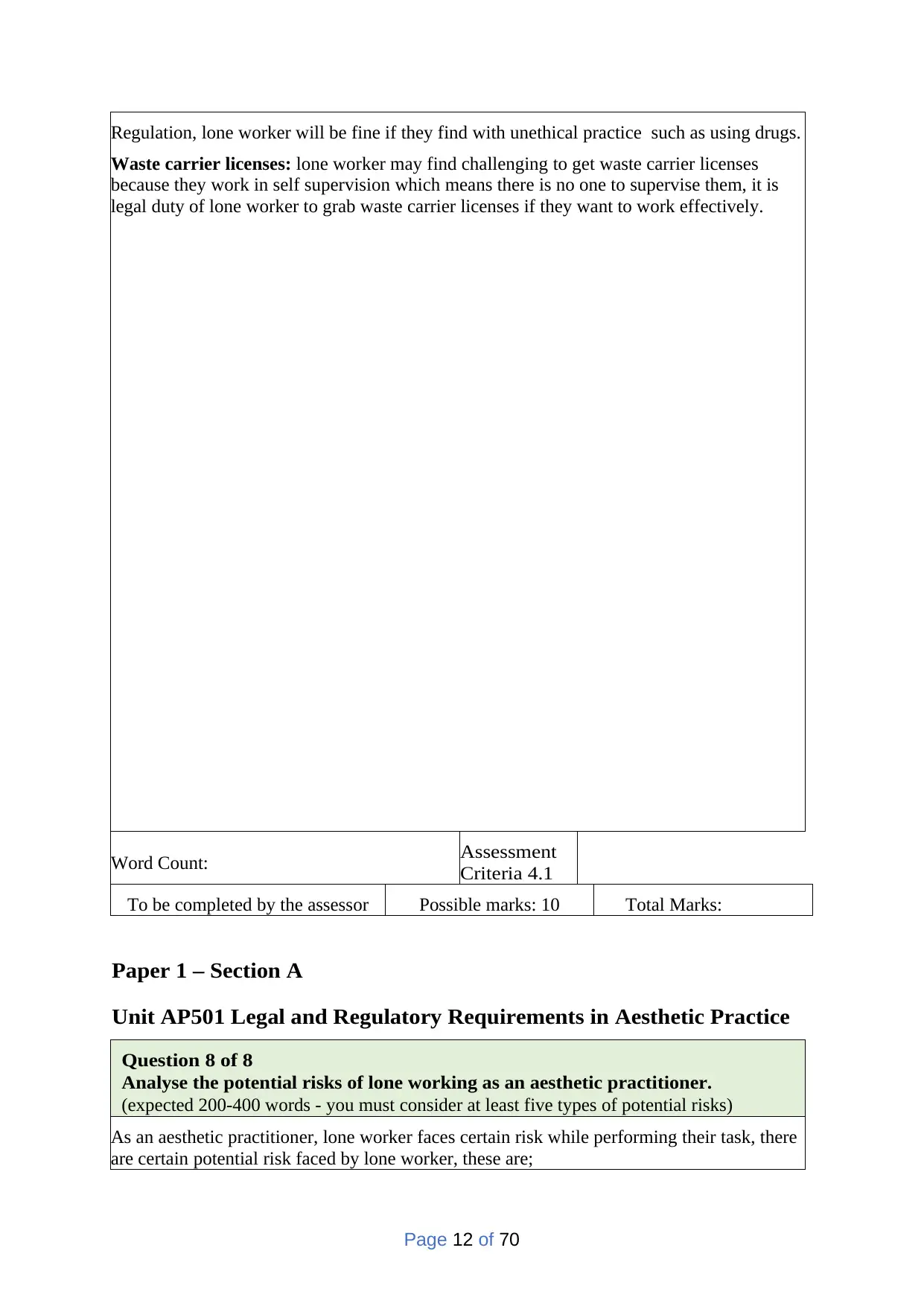
Regulation, lone worker will be fine if they find with unethical practice such as using drugs.
Waste carrier licenses: lone worker may find challenging to get waste carrier licenses
because they work in self supervision which means there is no one to supervise them, it is
legal duty of lone worker to grab waste carrier licenses if they want to work effectively.
Word Count: Assessment
Criteria 4.1
To be completed by the assessor Possible marks: 10 Total Marks:
Paper 1 – Section A
Unit AP501 Legal and Regulatory Requirements in Aesthetic Practice
Question 8 of 8
Analyse the potential risks of lone working as an aesthetic practitioner.
(expected 200-400 words - you must consider at least five types of potential risks)
As an aesthetic practitioner, lone worker faces certain risk while performing their task, there
are certain potential risk faced by lone worker, these are;
Page 12 of 70
Waste carrier licenses: lone worker may find challenging to get waste carrier licenses
because they work in self supervision which means there is no one to supervise them, it is
legal duty of lone worker to grab waste carrier licenses if they want to work effectively.
Word Count: Assessment
Criteria 4.1
To be completed by the assessor Possible marks: 10 Total Marks:
Paper 1 – Section A
Unit AP501 Legal and Regulatory Requirements in Aesthetic Practice
Question 8 of 8
Analyse the potential risks of lone working as an aesthetic practitioner.
(expected 200-400 words - you must consider at least five types of potential risks)
As an aesthetic practitioner, lone worker faces certain risk while performing their task, there
are certain potential risk faced by lone worker, these are;
Page 12 of 70
⊘ This is a preview!⊘
Do you want full access?
Subscribe today to unlock all pages.

Trusted by 1+ million students worldwide
1 out of 69
Related Documents
Your All-in-One AI-Powered Toolkit for Academic Success.
+13062052269
info@desklib.com
Available 24*7 on WhatsApp / Email
![[object Object]](/_next/static/media/star-bottom.7253800d.svg)
Unlock your academic potential
Copyright © 2020–2025 A2Z Services. All Rights Reserved. Developed and managed by ZUCOL.




